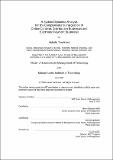| dc.contributor.advisor | Henry Birdseye Weil and Erik Brynjolfsson. | en_US |
| dc.contributor.author | Tomikawa, Hideaki, 1967- | en_US |
| dc.contributor.other | Massachusetts Institute of Technology. Management of Technology Program. | en_US |
| dc.date.accessioned | 2005-05-19T15:36:50Z | |
| dc.date.available | 2005-05-19T15:36:50Z | |
| dc.date.copyright | 2003 | en_US |
| dc.date.issued | 2003 | en_US |
| dc.identifier.uri | http://hdl.handle.net/1721.1/17003 | |
| dc.description | Thesis (S.M.M.O.T.)--Massachusetts Institute of Technology, Sloan School of Management, Management of Technology Program, 2003. | en_US |
| dc.description | Includes bibliographical references (leaves 146-148). | en_US |
| dc.description | This electronic version was submitted by the student author. The certified thesis is available in the Institute Archives and Special Collections. | en_US |
| dc.description.abstract | Problems are occurring in the digital business economy as companies try to realize a tangible profit. As network infrastructures improve, the value of information becomes less and less since marginal costs for digital goods is practically zero and searching the cost of goods is also extremely low. How, then, can the media industry remain profitable in the digital business economy? One way to retain the value of digital goods is through the use of firm governmental regulations, but this is still insufficient because of the ever-expanding network infrastructure and the growing threat of piracy. This thesis discusses potential strategies to be used in today's digital business economy based on current difficulties. It proposes an integrated business model for an on-line contents distribution business and an electronic payment business which complement each other. It is well-known that content distribution businesses are facing severe threats from piracy. By providing content for free as a complementary service for profitable businesses, it will be shown that media distribution companies can maximize the value of their contents library, which would otherwise be worthless in face of growing piracy. The thesis also discusses the migration process in an integrated business model by utilizing a System Dynamics approach to the analysis. The electronic payments business is regarded as a profit driver that can be complemented by the attractive value proposition of free online contents distribution businesses. For an infrastructure-oriented business like electronic payments, broad acceptance of such a service is critical to reducing customers' perceived risk. By introducing free content downloads, a business strategy is proposed that accelerates customer penetration and rapid migration to a profitable and integrated business of online contents distribution and electronic payment. By combining these two potentially successful two business models, a profitable business integration is proposed in which each business supplements the other in the digital business economy. | en_US |
| dc.description.statementofresponsibility | by Hideaki Tomikawa. | en_US |
| dc.format.extent | 181 leaves | en_US |
| dc.format.extent | 1589507 bytes | |
| dc.format.extent | 1626652 bytes | |
| dc.format.mimetype | application/pdf | |
| dc.format.mimetype | application/pdf | |
| dc.language.iso | eng | en_US |
| dc.publisher | Massachusetts Institute of Technology | en_US |
| dc.rights | M.I.T. theses are protected by copyright. They may be viewed from this source for any purpose, but reproduction or distribution in any format is prohibited without written permission. See provided URL for inquiries about permission. | en_US |
| dc.rights.uri | http://dspace.mit.edu/handle/1721.1/7582 | |
| dc.subject | Management of Technology Program. | en_US |
| dc.title | A system dynamics analysis for the complementary integration of online contents distribution businesses and electronic payment businesses | en_US |
| dc.type | Thesis | en_US |
| dc.description.degree | S.M.M.O.T. | en_US |
| dc.contributor.department | Management of Technology Program. | en_US |
| dc.contributor.department | Sloan School of Management | |
| dc.identifier.oclc | 54345098 | en_US |
